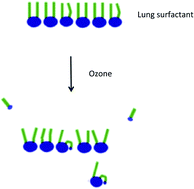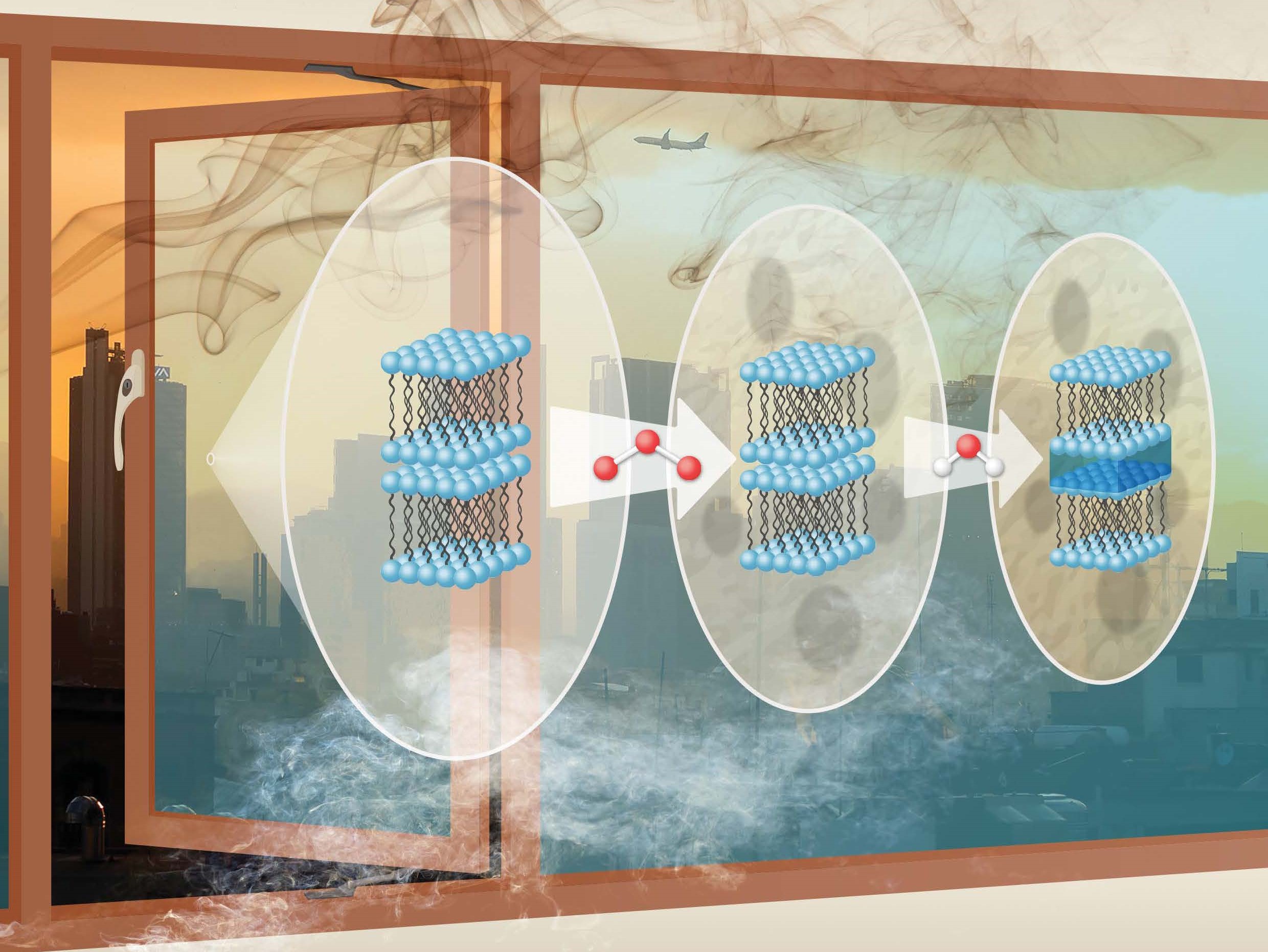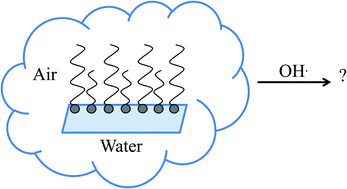The chemical and physical processes that occur in the atmosphere dictate which chemical species are present and these, in turn, may impact the global climate. The composition of the Earth's atmosphere has been changed significantly by human activity and some of these changes are harmful to human health, climate, crops and ecosystems.
Research in atmospheric chemistry conducted at ISIS aims to deepen our understanding of the causes of these problems and, by obtaining an understanding of them, allow possible solutions to be tested and provide scientific evidence that we be valuable to inform future government policies. Neutron reflectometry turns out to be very well suited for studying systems that model the interactions between particles in the atmosphere.
Clean air
Air pollution is a major cause of premature death and disease, and is the single largest environmental health risk in Europe. After being found guilty by the European Court of Justice of “systematically and persistently" breaching air pollution limits, in 2019 the UK Government created a Clean Air strategy, setting out their priorities to address this challenge. Research conducted at ISIS seeks to understand the impact of pollutants both on the atmosphere and on human health.
When nitrogen oxides are produced by vehicles, they can be broken down by sunlight and react with oxygen to form ozone, which is a key pollutant, especially in urban areas. Although global policies have been successful in reducing ozone levels in the lower atmosphere (while protecting the UV shielding ozone layer in the upper atmosphere), the gas is still present in urban locations, and beginning to rise in some areas of the world. Long term exposure to ozone is known to be harmful, so researchers used ISIS to study what damage the molecule does to the surfactant found in the lungs, and how this changed at different ozone concentrations.
 Their work, led by Katherine Thompson, published in Environmental Science: Atmospheres, looked at lung surfactant extracted from animal samples. An intact lung surfactant layer is essential for the proper functioning of the lungs. Infant respiratory distress syndrome (IRDS) for example, is caused by lack of surfactant, commonly seen in premature babies. The research team spread a molecularly thin film of lung surfactant on a water surface, thus simulating the outermost interface in the lung's alveoli. They found that, even at levels below 80 ppb, which we often would consider safe, the ozone detrimentally reacts with the phospholipid component of the lung surfactant. Their study confirms the risk to health of inhaling ozone, even at low levels.
Their work, led by Katherine Thompson, published in Environmental Science: Atmospheres, looked at lung surfactant extracted from animal samples. An intact lung surfactant layer is essential for the proper functioning of the lungs. Infant respiratory distress syndrome (IRDS) for example, is caused by lack of surfactant, commonly seen in premature babies. The research team spread a molecularly thin film of lung surfactant on a water surface, thus simulating the outermost interface in the lung's alveoli. They found that, even at levels below 80 ppb, which we often would consider safe, the ozone detrimentally reacts with the phospholipid component of the lung surfactant. Their study confirms the risk to health of inhaling ozone, even at low levels.
Climate change
Ozone also interacts with other organic molecules found in the atmosphere. Many of these molecules are found on the surface of atmospheric aerosol particles: tiny solid or liquid particles that are produced both naturally and by human activity such as burning fossil fuels. They can exist in the atmosphere for a few minutes or many days. These aerosols are the largest source of uncertainty when assessing man-made contributions to climate change, as they strongly influence the amount of light reflected back to space, and the formation and stability of clouds.
A research collaboration including ISIS scientists Maximilian Skoda and Rebecca Welbourn, Andy Ward from the Central Laser Facility, Martin King from Royal Holloway and Christian Pfrang from the University of Birmingham have used the Inter reflectometer at ISIS in order to observe how these organic molecules self-organise at the air-water and air-solid interface (thus mimicking liquid and solid aerosol particles) and how they interact with atmospheric oxidants (ozone, nitrate and hydroxyl radicals).
Using oleic acid as a model for the organic molecules, work led by Martin King studied the thin films that form on water droplets, as they would do in the atmosphere, using neutron reflectometry. They went on to study the interaction of these films with ozone, finding that the reaction is not impacted by the viscosity or salinity of the droplet, or the presence of an additional molecule at the interface.
Related research led by Christian Pfrang looked at the effects of realistic temperature and salinity conditions on the droplet system, finding that, at low temperatures (below 10°C), a residual surface film remained, while no organic material was left after the oxidation process at higher temperatures. The inert films remaining at low temperatures can then build up on liquid aerosols, even if the original pollutants themselves are short lived. This can reduce the surface pressure of the droplets, altering their behaviour in the cloud formation process.
The team also looked at the surface of solid aerosol  particles. Work led by Andy Ward and Martin King showed that these organic molecules form films around solid particles, and work led by Becky Welbourn and Martin King showed cloud processing of these organic is important. Dr Pfrang's team, again using oleic acid, investigated the structure of thin films that form at the solid-air interface. They found that, even though the organic molecules are oxidised on exposure to ozone, part of the thin films still remains present on the solid aerosol surface. This model system also provides insight into other surfaces, such as domestic windows, where fatty acids emitted during cooking are highly stable and not easily broken down in the atmosphere. That means that, when they hit a solid surface such as a window, they form a self-organised thin film that builds up over time and will only be very slowly broken down by other chemicals in the atmosphere. During this process, the film becomes rougher and attracts more water from the humidity in the air. In addition, toxic pollutants can become trapped underneath this persistent crust and are then protected from breakdown in the atmosphere, as illustrated in the graphic on the right.
particles. Work led by Andy Ward and Martin King showed that these organic molecules form films around solid particles, and work led by Becky Welbourn and Martin King showed cloud processing of these organic is important. Dr Pfrang's team, again using oleic acid, investigated the structure of thin films that form at the solid-air interface. They found that, even though the organic molecules are oxidised on exposure to ozone, part of the thin films still remains present on the solid aerosol surface. This model system also provides insight into other surfaces, such as domestic windows, where fatty acids emitted during cooking are highly stable and not easily broken down in the atmosphere. That means that, when they hit a solid surface such as a window, they form a self-organised thin film that builds up over time and will only be very slowly broken down by other chemicals in the atmosphere. During this process, the film becomes rougher and attracts more water from the humidity in the air. In addition, toxic pollutants can become trapped underneath this persistent crust and are then protected from breakdown in the atmosphere, as illustrated in the graphic on the right.
 Understanding how model systems behave is still a long way from knowing what happens in the real world. To bridge that gap, research led by Martin King studied pollutant particles taken from real-world environments. Unlike the model systems, these real-world samples contain different mixtures of molecules, depending on where they came from. The group used neutron reflectometry to look at samples from Antarctica and urban areas, and how they react with other molecules in the atmosphere. Rather than oxidation by ozone, the hydroxyl radical OH (one of the most reactive molecules found in the atmosphere) was used, and its reaction with the natural thin films was followed as a function of time. Currently, they are calculating how the films affect the amount of solar radiation reaching the surface of the Earth.
Understanding how model systems behave is still a long way from knowing what happens in the real world. To bridge that gap, research led by Martin King studied pollutant particles taken from real-world environments. Unlike the model systems, these real-world samples contain different mixtures of molecules, depending on where they came from. The group used neutron reflectometry to look at samples from Antarctica and urban areas, and how they react with other molecules in the atmosphere. Rather than oxidation by ozone, the hydroxyl radical OH (one of the most reactive molecules found in the atmosphere) was used, and its reaction with the natural thin films was followed as a function of time. Currently, they are calculating how the films affect the amount of solar radiation reaching the surface of the Earth.
Knowledge of the time evolution of the breakdown of thin films caused by the hydroxyl radical provides valuable empirical data for computer models, which is otherwise difficult to obtain. It also highlights key differences between the way pollutants behave and break down in 'real' atmospheric conditions compared to the way they behave in the laboratory.
The body of work outlined above demonstrates just some examples of how ISIS provides unique capabilities that bridge the gap between highly controlled laboratory experiments and field research in the very important area of atmospheric science. In collaboration with the CLF and the other partners of this ongoing project, funded through a grant from NERC, ISIS scientists continue to investigate the impact of atmospheric pollutants on our health and the climate.
To find out more about this area of research, contact beamline scientists Max Skoda and Becky Welbourn.
